Introduction to DeWalt Leaf Blowers
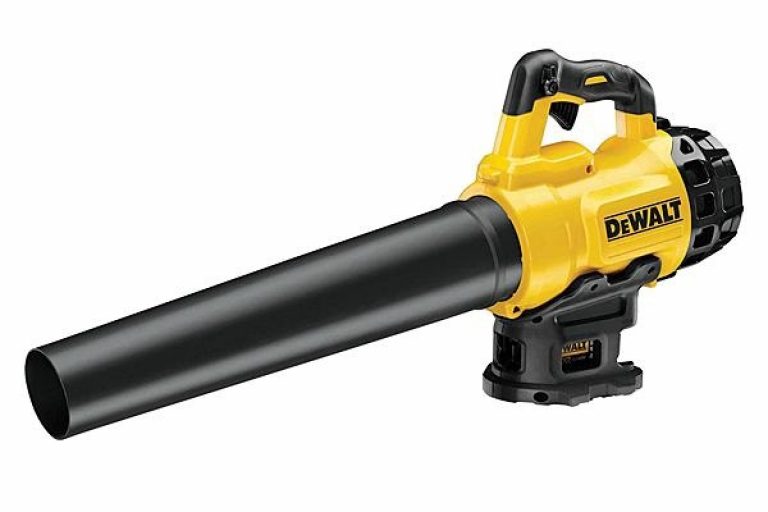
Leaf blowers aren’t just for dealing with leaves. You can also use them to shift twigs, grass cuttings, bits of bark and other small pieces of garden debris. They are great for blasting dust and dirt out of awkward nooks and crannies in your garage, shed, greenhouse or car boot as well.
Blowers are also ideal for getting rid of debris from loose surfaces which could be spoiled by raking. These include graveled paths and driveways, and flower beds containing bark, mulch or decorative pebbles.
What to look for in a Leaf Blower?

The following features are particularly useful in a leaf blower:
Variable Speed Control
Brushless Motor
Low Noise
Ergonomic Design
Powerful Battery
Variable Speed Control
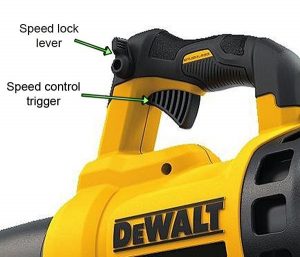
The ability to change the speed of your machine can be extremely useful, as a blower can send leaves shooting all over the garden if you’re not careful. With a variable speed trigger, you can slow down the air flow for greater accuracy when blowing near delicate plants, or trying to get leaves into a neat pile.
A speed lock is another handy feature. The DeWalt DCM562 blower lets you lock the speed at any time, so you don’t have to continually hold down the button. And even if you’re using the blower on a low setting, you can still press the trigger to go faster if you need a sudden blast of power – the DeWalt leaf blower can generate an air speed of up to 90mph.
Brushless Motor
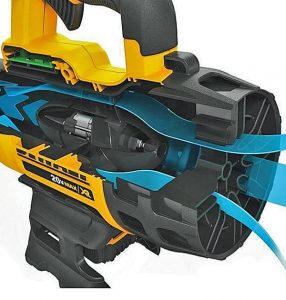
A brushless motor is far superior to one with brushes. This is because a brushed motor uses carbon brushes to deliver current to motor windings situated directly on the rotating shaft. This creates friction, which causes the brushes to wear out.
In a brushless motor, the windings are wrapped around the outer, stationary part of the motor. Magnetic sensors are used instead of direct contact with the rotating shaft, so no brushes are needed.
Friction, heat and noise are greatly reduced, resulting in a cooler and more efficient motor. The tool can be made lighter and more compact, as no brush housing is required. Run time is also greatly increased.
Low Noise
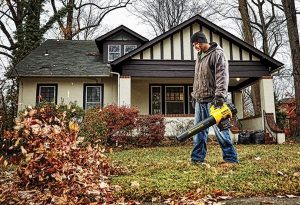
Leaf blowers can be extremely noisy, and many local councils ban their use on Sundays and at certain times of day during the rest of the week.
Choosing a relatively quiet machine can help you avoid antagonising your neighbours and enable you to use the tool for longer periods of time. The DeWalt DCM562 produces less than 65 decibels, making it one of the quietest on the market.
Ergonomic Design
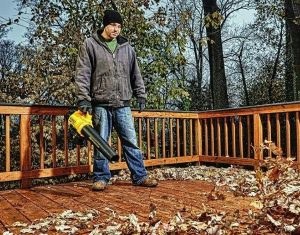
A well-balanced, compact and lightweight body will save on aching shoulders and make the blower straightforward to manoeuvre, giving you maximum control over the direction of the leaves.
Another useful feature is a good-sized, rubber cushioned handle. As you will be gripping it quite hard, it’s important to have a comfortable design.
Storage can sometimes be a problem due to the long tube. A blower that comes apart can be tucked away more easily in a shed or garage.
Powerful Battery
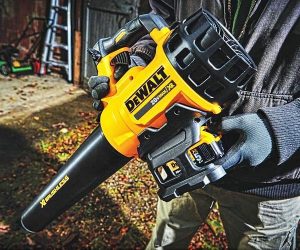
Petrol-driven leaf blowers have been in common use for a long time, but the development of Lithium-ion technology has made battery-operated blowers much more popular.
Lightweight yet powerful, a 5.0Ah battery offers generous run time and is extremely convenient. There is no petrol to store, no smell, and no need to worry about whether the tool will start – just press a button, and off you go.
Another plus point is that the batteries are interchangeable with those of other DeWalt power tools, so you can mix and match for extra flexibility.
Tips on using a Leaf Blower
- Wait for a dry day to get the blower out. Wet leaves will be much heavier and more difficult to shift. Rain could also harm your machine, as well as increasing the risk of electric shock.
- Avoid using the blower in breezy weather unless the wind happens to be blowing from behind you, in the same direction that you’re aiming for – although even then, you may encounter problems getting the leaves into a pile.
- Before you begin the job, plan where you want the leaves to finish up. Placing a plastic sheet or tarpaulin in the designated spot will make disposing of the leaves much quicker and easier. Anchor the sheet at intervals with bricks or large stones.
- Wear safety glasses, as blowers can throw up large amounts of dust and debris. Earplugs or ear defenders are also a good idea, particularly if you’re intending to work for an extended period of time.
- When you’re ready to start, hold the blower pointing downwards at a slight angle just above the ground and walk slowly forward. It’s tempting to sweep the machine from side to side, but this will only serve to scatter the leaves untidily. Instead, use a smooth back and forth movement to propel the leaves away from you. Work methodically, moving in one direction only. This will prevent you blowing leaves into parts of the garden that you’ve already cleared.
- If you find controlling the direction of the leaves difficult, practice blowing them against a wall or fence first, which is easier than trying to arrange them in a pile out in the open.
- Be extra careful when using the blower around delicate shrubs or flowers. Even with the speed turned down low, you could do serious damage if you go too close.
- When clearing a drive or pathway next to a lawn, you might find it more convenient to blow the leaves on to the grass and go over it with a lawnmower. This will partly shred the leaves and collect most of them in the grass box, then you can remove the last few using a rake.
- Disposing of the leaves afterwards is simple if you’ve been using a tarpaulin – just fold up the four corners to enclose the pile of leaves and drag it over to your compost heap or bin. A more time-consuming method is to pick up the leaves with two pieces of board before dropping them into garden sacks or a portable bin.






